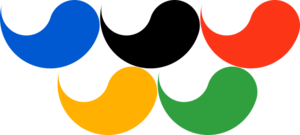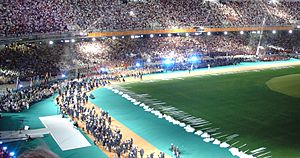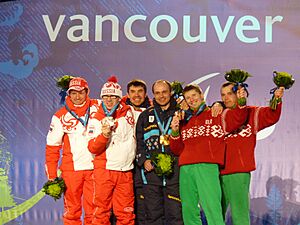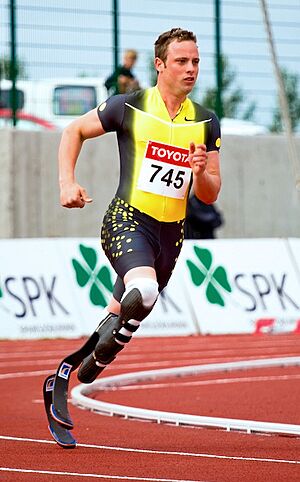Paralympic Games facts for kids
The Paralympic Games are huge international sports events for athletes with different kinds of disabilities. Just like the Olympic Games, there are Winter and Summer Paralympic Games. Since the 1988 Summer Olympics in Seoul, South Korea, the Paralympics have been held right after the Olympics in the same city. The International Paralympic Committee (IPC) runs all the Paralympic Games.
The Paralympics started small in 1948. It was a gathering of British World War II veterans. The 1960 Games in Rome had 400 athletes from 23 countries. Today, it's one of the biggest sports events in the world! For example, the 2020 Summer Paralympics had 4,520 athletes from 163 countries. Paralympic athletes work hard for equal treatment with Olympic athletes.
The Paralympic Games are set up much like the Olympic Games. There are also other big events for athletes with disabilities. The Special Olympics World Games are for athletes with intellectual disabilities. The Deaflympics are only for deaf athletes and have been held since 1924.
Because there are many types of disabilities, Para athletes compete in different groups. There are ten main types of disabilities allowed. These include weak muscles, limited movement, missing limbs, different leg lengths, short height, stiff muscles (hypertonia), poor balance (ataxia), uncontrolled movements (athetosis), sight problems, and intellectual disabilities. These main groups are then split into smaller ones.
Contents
How the Paralympics Started
Athletes with Disabilities in the Early Olympics
Did you know that athletes with disabilities competed in the Olympic Games even before the Paralympics began? For example, George Eyser, a German-American gymnast, competed in the 1904 Summer Olympics. He had an artificial leg!
Olivér Halassy, a Hungarian water polo player with a missing limb, played in three Olympic Games starting in 1928. Károly Takács from Hungary competed in shooting in the 1948 Summer Olympics and 1952 Summer Olympics. He had lost his right arm but learned to shoot with his left hand.
Another amazing athlete was Lis Hartel from Denmark. She got polio in 1943. She still won a silver medal in horse riding at the 1952 Summer Olympics.
The Stoke Mandeville Games
The first organized sports event for athletes with disabilities happened on the same day the 1948 Summer Olympics opened in London. A German-Jewish doctor named Ludwig Guttmann started it. He worked at Stoke Mandeville Hospital. He held a sports competition for British World War II veterans who had spinal cord injuries.
These first games were called the 1948 International Wheelchair Games. They were meant to happen at the same time as the 1948 Olympics. Dr. Guttmann wanted to create a top-level sports event for people with disabilities, just like the Olympics.
The games were held in the same place every year. In 1952, athletes from the Netherlands and Israel joined the British. This made it the first international competition of its kind. In 1960, the 9th annual games were held outside the UK for the first time, in Rome. They happened at the same time as the 1960 Summer Olympics. These games were later called the 1st Paralympic Games.
These early competitions were the start of the Paralympic Games. Stoke Mandeville is as important to the Paralympics as Greece is to the Olympics. Since 2012, the Paralympic flame has included a "heritage flame" lit at Stoke Mandeville. Starting in 2024, future Paralympic torch relays will officially begin there.
Important Moments in Paralympic History
The first official Paralympic Games were held in Rome in 1960. They were no longer just for war veterans. Four hundred athletes from 23 countries competed. Since 1960, the Paralympic Games have always taken place in the same year as the Olympic Games.
At first, only athletes in wheelchairs could compete. But at the 1976 Summer Games, athletes with different disabilities were included for the first time. This made the 1976 Games much bigger, with 1,600 athletes from 40 countries.
The 1988 Summer Paralympics in Seoul was another big step. In Seoul, the Summer Paralympics were held right after the 1988 Summer Olympics. They used the same host city and many of the same sports venues. This became a tradition that continued in 1992, 1996, and 2000.
This close link was made official in 2001 with an agreement between the International Paralympic Committee (IPC) and the International Olympic Committee (IOC). This agreement has been extended several times, most recently in 2018 to last until the 2032 Summer Olympics.
Winter Paralympic Games
The first Winter Paralympic Games were held in 1976 in Örnsköldsvik, Sweden. This was the first time many different types of athletes with disabilities could compete in the Winter Games.
The Winter Games used to be held every four years in the same year as the Summer Paralympics, just like the Olympics. This continued until the 1992 Games in Albertville, France. After that, starting with the 1994 Games, the Winter Paralympics and Winter Olympics began to be held in different even-numbered years. Now, the Winter Games happen two years after the Summer Games.
International Paralympic Committee

The International Paralympic Committee (IPC) is the main group that runs the Paralympic Movement around the world. It includes 178 National Paralympic Committees (NPCs) and four international sports groups for specific disabilities. The current president of the IPC is Andrew Parsons. The IPC's main office is in Bonn, Germany.
The IPC organizes both the Summer and Winter Paralympic Games. It also acts as the main group for nine sports: athletics, swimming, archery, powerlifting, alpine skiing, biathlon, cross-country skiing, ice sledge hockey, and wheelchair dancesport. For these sports, the IPC supervises World Championships and other competitions.
The IPC works closely with the International Olympic Committee (IOC). IPC members are also part of IOC committees. Even though they work together, the two groups are separate and have their own Games.
The Paralympic Games were created to show off the amazing athletic skills of the participants, not their disabilities. Recent games have really focused on showing what athletes *can* do. The movement has grown a lot. For example, in 1960, 400 athletes competed in Rome. By 2016 in Rio de Janeiro, there were 4,342 athletes from 159 countries! Both the Summer and Winter Paralympics are now recognized worldwide.
Unlike the Olympic Games, English is the official language of the Paralympic movement. Other languages used at each Games are the official languages of the host country. For example, during the opening ceremony, announcements are made in English and the host country's languages.
Name and Symbols

The name "Paralympic" first came from combining "paraplegic" (for people with spinal injuries) and "Olympic." But as more disability groups joined, this meaning wasn't quite right. Now, the name comes from the Greek word pará, which means 'beside' or 'alongside'. So, it means a competition held alongside the Olympic Games. The term "Paralympic" was first officially used at the 1988 Summer Paralympics in Seoul.
The motto for the Paralympic movement is "Spirit in Motion." The current Paralympic flag has been used since 2020. It has three colors: red, blue, and green. These are the most common colors in flags around the world. The colors are shaped like an Agito, which is Latin for 'I move'. The three Agitos circle a central point, showing athletes coming together from all over the world.
The IPC changed its motto and symbol in 2003. This was to show that Paralympians have a strong competitive spirit. It also showed that the IPC is moving forward to reach its goals. The IPC's goal is "To enable Paralympic athletes to achieve sporting excellence and to inspire and excite the world." The Paralympic anthem is "Hymne de l'Avenir" (Anthem of the Future). It was written by Thierry Darnis and became the official anthem in 1996.
Ceremonies
Opening Ceremony
The opening ceremony of the Paralympic Games has many special parts, just like the Olympics. It usually starts with raising the host country's flag and playing its national anthem. After that, the "Parade of Nations" begins. Athletes from each country march into the stadium, grouped by their nation.
Since the 1960 Summer Paralympics, countries enter in alphabetical order based on the host country's language. The host country's athletes always enter last. Starting with the 2020 Summer Paralympics, the countries that will host the next Olympic Games enter just before the current host. The host nation also puts on artistic shows that celebrate their culture.
Next, speeches are given, and the Games are officially opened. The Paralympic flag is brought into the stadium and raised while the Paralympic Anthem plays. Athletes, coaches, and judges take oaths. Finally, the Paralympic flame is carried into the stadium. It is passed along until it reaches the last torch carrier, often a Paralympic athlete from the host country. This person lights the Paralympic flame in the stadium's cauldron.
Closing Ceremony
The closing ceremony happens after all the sports events are finished. Flag-bearers from each country enter, followed by all the athletes together. They enter without being grouped by nation.
The Paralympic flag is taken down. Since the 1988 Winter Paralympics, the flag of the country hosting the next Summer or Winter Paralympic Games is raised. Its national anthem is played. The games are officially closed, and the Paralympic flame is put out. After these parts, the next host nation gives a short performance to introduce its culture.
Medal Presentation
After each Paralympic event, there is a medal ceremony. The first, second, and third-place athletes or teams stand on a special platform. An IPC member gives them their medals. Then, the national flags of the medal winners are raised, and the national anthem of the gold medalist is played. Volunteers from the host country help with the ceremonies, assisting officials and carrying flags. Medal ceremonies usually happen within one day after the event finishes.
Working Together
Paralympics and Olympics
In June 2001, the International Olympic Committee (IOC) and the International Paralympic Committee (IPC) made an agreement. This agreement means that when a city bids to host the Olympic Games, it must also include plans for hosting the Paralympic Games. This started with the 2008 Paralympic Summer Games in Beijing.
This agreement has been updated and extended several times. As of 2025, all cities announced to host future Summer and Winter Games are preparing for both the Olympics and Paralympics together. This was confirmed again in March 2018, extending the agreement until the 2032 Summer Olympics.
The IOC has stated in its Olympic Charter that everyone should have equal access to sports. It says that practicing sport is a human right, and there should be no discrimination. While it doesn't specifically mention disability, the idea is that discrimination based on disability goes against the Olympic spirit. The Paralympic Charter also forbids discrimination based on many reasons, including disability.
Sebastian Coe, who led the organizing committee for the 2012 Summer Paralympics and 2012 Summer Olympics in London, said they wanted to change how people view disability. They aimed to celebrate the excellence of Paralympic sport and show that the two Games are one complete event.
The 2014 Winter Paralympic Games were the first hosted by Russia. Russia had recently agreed to the UN Convention on the Rights of Persons with Disabilities. At the 2010 Vancouver Games, Russia's Paralympic team won the most medals, while their Olympic team didn't do as well. This made people notice the success of the Paralympic athletes, even though Olympic athletes often get more attention and money. The organizers of the 2014 Games in Sochi worked to make the city more accessible.
In 2012, the Paralympic movement asked athletes to cover any tattoos of the Olympic rings during competitions. This was because the Olympics was seen as a separate organization. However, this rule was changed in 2024 after athletes protested.
Paralympians at the Olympics
Some Paralympic athletes have also wanted to compete in the Olympic Games. Neroli Fairhall, a Paralympic archer from New Zealand, was the first paraplegic athlete to compete in the 1984 Summer Olympics.
In 2008, Oscar Pistorius, a sprinter from South Africa, tried to qualify for the 2008 Summer Olympics. He had both legs amputated below the knee and ran with special carbon fiber blades. He was very close to qualifying for the 400-meter race. He then won gold medals in the 100, 200, and 400-meter sprints at the 2008 Summer Paralympics.
In 2011, Pistorius did qualify for the 2012 Summer Olympics. He ran in the 400-meter race and his team competed in the 4x400-meter relay. While athletes are given equal chances, some people have worried if the games are always fair. For example, some think that athletes with a left prosthetic leg might have a disadvantage in races run counter-clockwise.
Some athletes without disabilities also compete in the Paralympics. For example, sighted guides for athletes with visual impairments are a very important part of the team. They are considered part of the team and can also win medals.
Funding
Since the 1992 Summer Paralympics, major sponsors have helped support the Games. Unlike the Olympics, where sponsor logos are usually hidden, the Paralympics allow official sponsor logos to be shown in arenas and on uniforms.
Media Coverage
The Olympic Games have gained a lot of media coverage since 1984. The Paralympics have been slower to get consistent attention from major media. However, in June 2023, the IPC said that broadcasters were showing more interest in the Paralympics. They had already made deals for the 2024 Summer Paralympics that covered 75% of the world. This was much better than in 2020, when many deals were made at the last minute. The IPC is pushing for more coverage and higher fees because broadcasters are realizing the Paralympics are "a great sporting event."
Television broadcasts of the Paralympic Games started in 1976. But this early coverage was often delayed and only shown in one country or region. At the 1992 Summer Paralympics, there were 45 hours of live coverage, but only in Europe. Other countries showed highlight packages.
The 2000 Summer Paralympics in Sydney brought a big increase in global media attention. A deal was made to broadcast the Games internationally. Coverage reached Asia, South America, and Europe. The Games were also shown online for the first time. Because of these efforts, the Sydney Paralympics reached about 300 million people worldwide. Also, the organizers didn't have to pay TV networks to show the Games, which had happened in 1992 and 1996.
Despite these improvements, getting consistent media attention has been a challenge. For example, the BBC was criticized for showing very little of the 2010 Winter Paralympics compared to its coverage of the 2010 Winter Olympics. The BBC said it was due to budget limits and time zone differences. This was despite the 2008 Summer Paralympics having good ratings in Great Britain.
Not all Paralympic events have been shown on TV. The IPC now works with the IOC's media group, Olympic Broadcasting Services (OBS), to produce the broadcasts. At the Summer Paralympics, coverage was limited to 16 sports in 2016, but it increased to 19 sports in 2020. In 2024, all 22 Summer Paralympic sports were televised for the first time.
In the UK, Channel 4 started broadcasting the Games with the 2012 Summer Paralympics. They promised much more coverage on TV and online. They also worked to include people with disabilities among their staff and presenters. Their marketing campaigns for the Paralympics have won awards. In January 2020, the Paralympics were made a "listed event" in Britain, meaning they must be shown on free-to-air TV, just like the Olympics. Channel 4 reported that 20 million people watched its coverage of the 2024 Summer Paralympics.
Impact Outside the Games
A 2010 study by the University of British Columbia looked at the impact of the Olympic Games. It found that about 41 to 50 percent of Canadians believed the 2010 Paralympic and Olympic Games in Vancouver, Canada, helped make buildings, sidewalks, and public places more accessible. Also, 23 percent of employers said the Games made them more willing to hire people with disabilities.
Xavier Gonzalez, CEO of the International Paralympic Committee, said about the 2008 Summer Paralympics in Beijing, China: "In China, the (Paralympic) Games really helped change attitudes towards people with disabilities. They led to building accessible facilities in the city and changing laws to allow people with disabilities to be part of society."
Down Syndrome Participation
There have been discussions about including athletes with Down syndrome in the Paralympic Games. While the Paralympics want to include everyone, there isn't a specific category for athletes with Down syndrome in swimming events. This raises questions about fair competition for them.
The International Paralympic Committee's swimming rules are usually based on only one type of disability. People with Down syndrome often have both physical and intellectual disabilities. Swimmers with Down syndrome can compete in the S14 intellectual impairment category. However, they are often outmatched by other athletes who might be physically stronger. Right now, there is no special Paralympic category just for swimmers with Down syndrome, which means their physical disabilities are not fully considered.
Many groups around the world are asking for a special category for swimmers with Down syndrome. They want to make sure these athletes have equal chances. Even with these efforts, the issue is still being worked on. Swimmers with Down syndrome continue to face challenges in finding the right way to be classified.
Classification of Athletes
Disability Categories
The International Paralympic Committee (IPC) has set up ten disability categories. These include physical, visual, and intellectual impairments. Athletes with one of these disabilities can compete in the Paralympics. Within each category, athletes are grouped by how much their disability affects their performance. This system is different for each sport. These categories are used for both Summer and Winter Paralympics.
Physical Impairment – There are eight types of physical impairment:
- Weak muscles – Muscles might be weaker in one limb, one side of the body, or the lower body. Examples include spinal cord injury or spina bifida.
- Limited movement – The range of movement in one or more joints is reduced. This does not include temporary conditions like arthritis.
- Missing limb – A total or partial absence of bones or joints due to amputation or being born without them.
- Leg-length difference – One leg is much shorter than the other due to birth defects or injury.
- Short height – Standing height is reduced because of shorter legs, arms, and body, often due to bone or cartilage problems. Examples include achondroplasia.
- Hypertonia – Muscles are unusually stiff and hard to stretch. This can happen from injuries or conditions affecting the brain or spinal cord, like cerebral palsy.
- Ataxia – This means a lack of muscle coordination. Examples include cerebral palsy or multiple sclerosis.
- Athetosis – This involves unbalanced, uncontrolled movements and difficulty holding a steady posture. An example is cerebral palsy.
Visual Impairment – Athletes with vision problems, from partial vision (legally blind) to total blindness. This includes problems with any part of the eye or brain that handles sight. The sighted guides for athletes with visual impairments are so important that the athlete and guide are considered a team. Since 2012, these guides and sighted goalkeepers in 5-a-side football can also receive medals.
Intellectual Disability – Athletes with a significant intellectual disability and related challenges in daily life. The IPC mainly works with athletes with physical disabilities, but intellectual disability has been added to some Paralympic Games. This group includes only top athletes whose intellectual disability was diagnosed before age 18. However, the Special Olympics World Games are open to all people with intellectual disabilities.
How Athletes are Classified
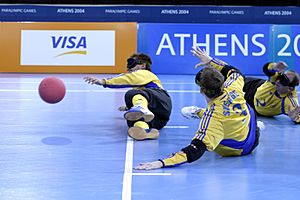
The Paralympics use a system that looks at how an athlete's disability affects their sports performance. This is called a functional classification system. For example, athletes who have lost all function in their legs will compete together in most sports, because their ability to perform is similar, no matter why they lost the function.
For sports like Paralympic swimming or athletics, which are open to many different impairments, athletes are put into classes. These classes are based on their disability and how severe it is. This helps make sure that an athlete's disability doesn't give them too much of an advantage or disadvantage against others. For example, in athletics and swimming, athletes with visual impairments compete in categories 11-13. Category 11 athletes have very little or no sight, while category 13 athletes have the least severe vision problems that still qualify for Paralympic sport.
Making Competition Fair for Athletes
In some sports, athletes might need to use special equipment to make the physical differences between them more equal. For example, the Paralympics has three levels of visual impairment. Swimmers in the S11 category have the most severe vision problems. All swimmers in this group must wear blacked-out goggles. This makes sure no one has an advantage from having slightly better vision.
Fair Play in Team Sports
There are also team sports like wheelchair rugby or relay swimming where teams are classified as a group. Each athlete gets a point value based on how much their disability affects their activity. A lower score means a more severe limitation. A team cannot have more than a certain total number of points on the field at one time. This helps keep the competition fair. For example, in wheelchair rugby, the four players on a team cannot have a combined disability score of more than eight points. In swimming relays, there are four categories, each with different total points allowed for the team.
Sports
There are 22 sports in the Summer Paralympic program and six sports in the Winter Paralympics program. Some sports have several different events. For example, alpine skiing includes downhill, super combined, super-G, slalom, and giant slalom.
The IPC manages some of these sports, but not all. Other international groups, called International Sports Federations (IF), manage sports specific to certain disability groups. These include the International Wheelchair and Amputee Sports Federation (IWAS), the International Blind Sports Federation (IBSA), and the Cerebral Palsy International Sports and Recreation Association (CP-ISRA). There are also national groups for these federations, including National Paralympic Committees. These groups are in charge of finding athletes and managing sports at the national level.
Cheating Concerns
After the 2000 Summer Paralympics in Sydney, a Spanish basketball player claimed that some members of his gold-medal-winning team for intellectual disabilities (ID) did not actually have disabilities. He said only two out of twelve players met the requirements. This caused a big problem, and the International Paralympic Committee (IPC) asked Spain to investigate. The investigation found that some Spanish athletes had indeed broken the rules. The head of the federation for ID competition admitted that athletes worldwide were cheating the ID rules.
The IPC started its own investigation. It confirmed the claims and found that this problem wasn't just in basketball or with Spanish athletes. Because of this, all ID competitions were stopped for a while. The ban was lifted after the 2008 Games, once stricter rules and checks were put in place for athletes with intellectual disabilities. Four sports – swimming, athletics, table tennis, and rowing – were expected to have competitions for ID athletes at the 2012 Summer Paralympics.
The Paralympics have also faced issues with athletes using banned substances (steroids). At the 2008 Games in Beijing, three powerlifters and a German basketball player were banned for testing positive. This was fewer than the ten powerlifters and one track athlete banned from the 2000 Games. German skier Thomas Oelsner was the first Winter Paralympian to test positive for steroids. He lost his two gold medals from the 2002 Winter Paralympics because of it. At the 2010 Winter Paralympics in Vancouver, Swedish curler Glenn Ikonen tested positive and was suspended for six months. He was removed from the curling competition, but his team was allowed to continue. He said his doctor had prescribed a banned medication.
Another concern for Paralympic officials is a technique called "boosting." Athletes can purposely raise their blood pressure, often by causing minor harm to themselves. This has been shown to improve performance by up to 15%. It is most effective in endurance sports like cross-country skiing. To raise blood pressure, athletes might deliberately injure limbs below a spinal injury. This could involve breaking bones, tying limbs too tightly, or using very tight compression stockings. The injury itself is painless, but it affects the athlete's blood pressure.
Another possible concern is the use of gene therapy among Paralympic athletes. All Paralympic athletes are not allowed to improve their abilities through "gene doping." However, it is very hard to tell the difference between gene doping and helpful gene therapy. The World Anti-Doping Agency (WADA) is studying both to understand the line between them.
The IPC has been working with WADA since 2003 to make sure Paralympic athletes follow WADA's anti-doping rules. The IPC has also promised to test more athletes at each Games to reduce doping. They have also started mandatory testing both during and outside of competitions.
After sending samples for testing, the IPC found proof that widespread doping by Russian athletes happened at the 2014 Winter Paralympics in Sochi. On August 7, 2016, the IPC decided to ban the entire Russian team from the 2016 Summer Paralympics. They said the Russian Paralympic Committee could not enforce the anti-doping rules. IPC President Sir Philip Craven said the Russian government had "catastrophically failed its Para athletes."
Amazing Champions and Achievements
Trischa Zorn from the United States is the most decorated Paralympian ever. She competed in blind swimming events and won a total of 55 medals, with 41 of them being gold! Her Paralympic career lasted 24 years, from 1980 to 2004. She was also an alternate for the 1980 American Olympic swim team but didn't go to the Olympics because of a boycott.
Ragnhild Myklebust from Norway holds the record for the most medals won at the Winter Paralympic Games. She competed in many events between 1988 and 2002, winning a total of 22 medals, including 17 gold. She retired at age 58 after winning five gold medals at the 2002 Games.
Neroli Fairhall, a paraplegic archer from New Zealand, was the first paraplegic competitor, and the third Paralympian, to take part in the Olympic Games. She competed in the 1984 Summer Olympics in Los Angeles. She finished thirty-fourth in the Olympic archery competition and also won a Paralympic gold medal in the same event.
Host Cities
| Year | Summer Paralympic Games | Winter Paralympic Games | ||||
|---|---|---|---|---|---|---|
| Edition | Host(s) | Top nation | Edition | Host(s) | Top nation | |
| 1960 | 1 | |||||
| 1964 | 2 | |||||
| 1968 | 3 | |||||
| 1972 | 4 | |||||
| 1976 | 5 | 1 | ||||
| 1980 | 6 | 2 | ||||
| 1984 | 7 | 3 | ||||
| 1988 | 8 | 4 | ||||
| 1992 | 9 | 5 | ||||
| 1994 | 6 | |||||
| 1996 | 10 | |||||
| 1998 | 7 | |||||
| 2000 | 11 | |||||
| 2002 | 8 | |||||
| 2004 | 12 | |||||
| 2006 | 9 | |||||
| 2008 | 13 | |||||
| 2010 | 10 | |||||
| 2012 | 14 | |||||
| 2014 | 11 | |||||
| 2016 | 15 | |||||
| 2018 | 12 | |||||
| 2020 | 16 | |||||
| 2022 | 13 | |||||
| 2024 | 17 | |||||
| 2026 | 14 | |||||
| 2028 | 18 | |||||
| 2030 | 15 | |||||
| 2032 | 19 | |||||
| 2034 | 16 | |||||
The 2020 Summer Paralympics were postponed to 2021 because of the COVID-19 pandemic. This was the first time the Paralympic Games had been postponed. They are still called the 2020 Summer Paralympics, even though they happened a year later, from August 24 to September 5, 2021.
See also
 In Spanish: Juegos Paralímpicos para niños
In Spanish: Juegos Paralímpicos para niños
- All-time Paralympic Games medal table
- Parapan American Games
- Asian Para Games
- Commonwealth Paraplegic Games
- Cybathlon
- Disability flag


